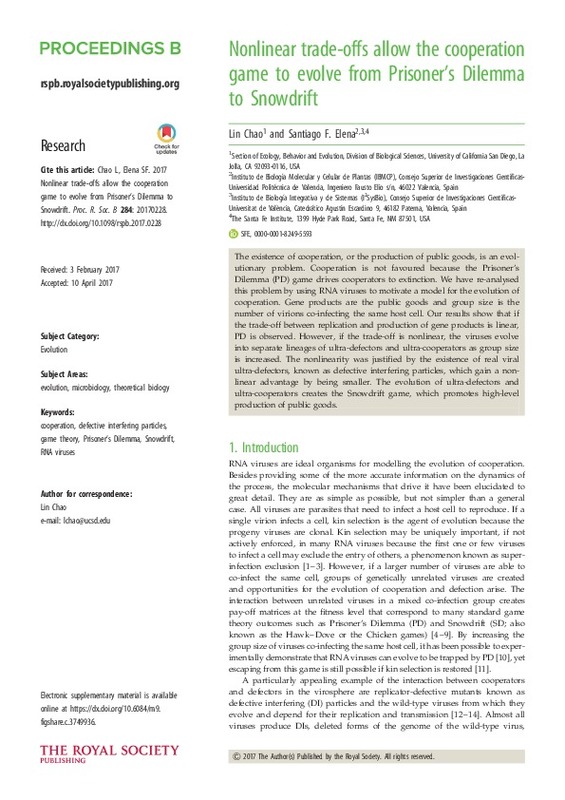Whitaker-Dowling, P., Ungner, J. S., Widnell, C. C., & Wilcox, D. K. (1983). Superinfect on exclusion by vesicular stomatitis virus. Virology, 131(1), 137-143. doi:10.1016/0042-6822(83)90540-8
Doebeli, M. (2004). The Evolutionary Origin of Cooperators and Defectors. Science, 306(5697), 859-862. doi:10.1126/science.1101456
Doebeli, M., & Hauert, C. (2005). Models of cooperation based on the Prisoner’s Dilemma and the Snowdrift game. Ecology Letters, 8(7), 748-766. doi:10.1111/j.1461-0248.2005.00773.x
[+]
Whitaker-Dowling, P., Ungner, J. S., Widnell, C. C., & Wilcox, D. K. (1983). Superinfect on exclusion by vesicular stomatitis virus. Virology, 131(1), 137-143. doi:10.1016/0042-6822(83)90540-8
Doebeli, M. (2004). The Evolutionary Origin of Cooperators and Defectors. Science, 306(5697), 859-862. doi:10.1126/science.1101456
Doebeli, M., & Hauert, C. (2005). Models of cooperation based on the Prisoner’s Dilemma and the Snowdrift game. Ecology Letters, 8(7), 748-766. doi:10.1111/j.1461-0248.2005.00773.x
Kümmerli, R., Colliard, C., Fiechter, N., Petitpierre, B., Russier, F., & Keller, L. (2007). Human cooperation in social dilemmas: comparing the Snowdrift game with the Prisoner’s Dilemma. Proceedings of the Royal Society B: Biological Sciences, 274(1628), 2965-2970. doi:10.1098/rspb.2007.0793
Szathmáry, E. (1992). Natural selection and dynamical coexistence of defective and complementing virus segments. Journal of Theoretical Biology, 157(3), 383-406. doi:10.1016/s0022-5193(05)80617-4
Kirkwood, T. B., & Bangham, C. R. (1994). Cycles, chaos, and evolution in virus cultures: a model of defective interfering particles. Proceedings of the National Academy of Sciences, 91(18), 8685-8689. doi:10.1073/pnas.91.18.8685
Bangham, C. (1990). Defective interfering particles: Effects in modulating virus growth and persistence. Virology, 179(2), 821-826. doi:10.1016/0042-6822(90)90150-p
Cole, C. N., & Baltimore, D. (1973). Defective interfering particles of poliovirus. Journal of Molecular Biology, 76(3), 345-361. doi:10.1016/0022-2836(73)90509-3
Giachetti, C., & Holland, J. J. (1988). Altered replicase specificity is responsible for resistance to defective interfering particle interference of an Sdi- mutant of vesicular stomatitis virus. Journal of Virology, 62(10), 3614-3621. doi:10.1128/jvi.62.10.3614-3621.1988
Giachetti, C., & Holland, J. J. (1989). Vesicular stomatitis virus and its defective interfering particles exhibit in vitro transcriptional and replicative competition for purified L-NS polymerase molecules. Virology, 170(1), 264-267. doi:10.1016/0042-6822(89)90375-9
Horodyski, F. M., & Holland, J. J. (1984). Reconstruction Experiments Demonstrating Selective Effects of Defective Interfering Particles on Mixed Populations of Vesicular Stomatitis Virus. Journal of General Virology, 65(4), 819-823. doi:10.1099/0022-1317-65-4-819
Kolakofsky, D. (1976). Isolation and characterization of Sendai virus DI-RNAs. Cell, 8(4), 547-555. doi:10.1016/0092-8674(76)90223-3
Nayak, D. P., Sivasubramanian, N., Davis, A. R., Cortini, R., & Sung, J. (1982). Complete sequence analyses show that two defective interfering influenza viral RNAs contain a single internal deletion of a polymerase gene. Proceedings of the National Academy of Sciences, 79(7), 2216-2220. doi:10.1073/pnas.79.7.2216
Nonoyama, M., & Graham, A. F. (1970). Appearance of Defective Virions in Clones of Reovirus. Journal of Virology, 6(5), 693-694. doi:10.1128/jvi.6.5.693-694.1970
Weiss, B., Goran, D., Cancedda, R., & Schlesinger, S. (1974). Defective Interfering Passages of Sindbis Virus: Nature of the Intracellular Defective Viral RNA. Journal of Virology, 14(5), 1189-1198. doi:10.1128/jvi.14.5.1189-1198.1974
Lopez, C. B. (2014). Defective Viral Genomes: Critical Danger Signals of Viral Infections. Journal of Virology, 88(16), 8720-8723. doi:10.1128/jvi.00707-14
Frensing, T. (2015). Defective interfering viruses and their impact on vaccines and viral vectors. Biotechnology Journal, 10(5), 681-689. doi:10.1002/biot.201400429
Notton, T., Sardanyés, J., Weinberger, A. D., & Weinberger, L. S. (2014). The case for transmissible antivirals to control population-wide infectious disease. Trends in Biotechnology, 32(8), 400-405. doi:10.1016/j.tibtech.2014.06.006
Dixit, N. M., & Perelson, A. S. (2004). Multiplicity of Human Immunodeficiency Virus Infections in Lymphoid Tissue. Journal of Virology, 78(16), 8942-8945. doi:10.1128/jvi.78.16.8942-8945.2004
Gutiérrez, S., Yvon, M., Thébaud, G., Monsion, B., Michalakis, Y., & Blanc, S. (2010). Dynamics of the Multiplicity of Cellular Infection in a Plant Virus. PLoS Pathogens, 6(9), e1001113. doi:10.1371/journal.ppat.1001113
Tromas, N., Zwart, M. P., Lafforgue, G., & Elena, S. F. (2014). Within-Host Spatiotemporal Dynamics of Plant Virus Infection at the Cellular Level. PLoS Genetics, 10(2), e1004186. doi:10.1371/journal.pgen.1004186
Akpinar, F., Inankur, B., & Yin, J. (2016). Spatial-Temporal Patterns of Viral Amplification and Interference Initiated by a Single Infected Cell. Journal of Virology, 90(16), 7552-7566. doi:10.1128/jvi.00807-16
Bangham, C. R. M., & Kirkwood, T. B. L. (1993). Defective interfering particles and virus evolution. Trends in Microbiology, 1(7), 260-264. doi:10.1016/0966-842x(93)90048-v
Jacobson, S., Dutko, F. J., & Pfau, C. J. (1979). Determinants of Spontaneous Recovery and Persistence in MDCK Cells Infected with Lymphocytic Choriomeningitis Virus. Journal of General Virology, 44(1), 113-122. doi:10.1099/0022-1317-44-1-113
Thompson, K. A. S., & Yin, J. (2010). Population dynamics of an RNA virus and its defective interfering particles in passage cultures. Virology Journal, 7(1). doi:10.1186/1743-422x-7-257
Timm, C., Akpinar, F., Yin, J., & Lyles, D. S. (2013). Quantitative Characterization of Defective Virus Emergence by Deep Sequencing. Journal of Virology, 88(5), 2623-2632. doi:10.1128/jvi.02675-13
Brinton, M. A., & Fernandez, A. V. (1983). A replication-efficient mutant of West Nile virus is insensitive to DI particle interference. Virology, 129(1), 107-115. doi:10.1016/0042-6822(83)90399-9
DePolo, N. J., Giachetti, C., & Holland, J. J. (1987). Continuing coevolution of virus and defective interfering particles and of viral genome sequences during undiluted passages: virus mutants exhibiting nearly complete resistance to formerly dominant defective interfering particles. Journal of Virology, 61(2), 454-464. doi:10.1128/jvi.61.2.454-464.1987
Kawai, A., & Matsumoto, S. (1977). Interfering and noninterfering defective particles generated by a rabies small plaque variant virus. Virology, 76(1), 60-71. doi:10.1016/0042-6822(77)90282-3
Zwart, M. P., Pijlman, G. P., Sardanyés, J., Duarte, J., Januário, C., & Elena, S. F. (2013). Complex dynamics of defective interfering baculoviruses during serial passage in insect cells. Journal of Biological Physics, 39(2), 327-342. doi:10.1007/s10867-013-9317-9
[-]








